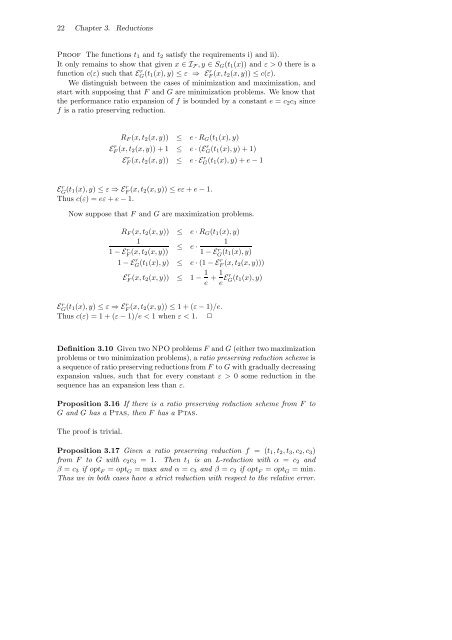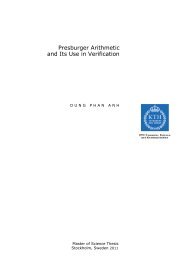On the Approximability of NP-complete Optimization Problems
On the Approximability of NP-complete Optimization Problems
On the Approximability of NP-complete Optimization Problems
Create successful ePaper yourself
Turn your PDF publications into a flip-book with our unique Google optimized e-Paper software.
22 Chapter 3. Reductions<br />
Pro<strong>of</strong> The functions t1 and t2 satisfy <strong>the</strong> requirements i) and ii).<br />
It only remains to show that given x ∈IF ,y ∈ SG(t1(x)) and ε>0<strong>the</strong>reisa<br />
function c(ε) such that E r G (t1(x),y) ≤ ε ⇒ E r F (x, t2(x, y)) ≤ c(ε).<br />
We distinguish between <strong>the</strong> cases <strong>of</strong> minimization and maximization, and<br />
start with supposing that F and G are minimization problems. We know that<br />
<strong>the</strong> performance ratio expansion <strong>of</strong> f is bounded by a constant e = c2c3 since<br />
f is a ratio preserving reduction.<br />
RF (x, t2(x, y)) ≤ e · RG(t1(x),y)<br />
E r F (x, t2(x, y)) + 1 ≤ e · (E r G (t1(x),y)+1)<br />
E r F (x, t2(x, y)) ≤ e ·E r G(t1(x),y)+e − 1<br />
E r G (t1(x),y) ≤ ε ⇒E r F (x, t2(x, y)) ≤ eε + e − 1.<br />
Thus c(ε) =eε + e − 1.<br />
Now suppose that F and G are maximization problems.<br />
RF (x, t2(x, y)) ≤ e · RG(t1(x),y)<br />
1<br />
1 −E r F (x, t2(x, y))<br />
≤ e ·<br />
1<br />
1 −E r G (t1(x),y)<br />
1 −E r G (t1(x),y) ≤ e · (1 −E r F (x, t2(x, y)))<br />
E r F (x, t2(x, y)) ≤ 1 − 1 1<br />
+<br />
e e Er G(t1(x),y)<br />
E r G (t1(x),y) ≤ ε ⇒E r F (x, t2(x, y)) ≤ 1+(ε − 1)/e.<br />
Thus c(ε) =1+(ε − 1)/e < 1whenε0 some reduction in <strong>the</strong><br />
sequence has an expansion less than ε.<br />
Proposition 3.16 If <strong>the</strong>re is a ratio preserving reduction scheme from F to<br />
G and G has a Ptas,<strong>the</strong>n F has a Ptas.<br />
The pro<strong>of</strong> is trivial.<br />
Proposition 3.17 Given a ratio preserving reduction f = (t1,t2,t3,c2,c3)<br />
from F to G with c2c3 = 1. Then t1 is an L-reduction with α = c2 and<br />
β = c3 if opt F = opt G =maxand α = c3 and β = c2 if opt F = opt G =min.<br />
Thus we in both cases have a strict reduction with respect to <strong>the</strong> relative error.

















